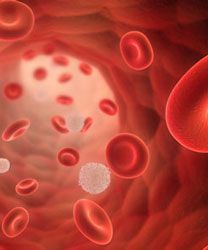Article
No Benefit With Prolonged Native E. Coli Asparaginase in Pediatric ALL, NHL
Author(s):
Treatment with prolonged native E. coli asparaginase therapy for children with acute lymphoblastic leukemia or non-Hodgkin lymphoma not only failed to improve survival versus the standard regimen, but also resulted in an increase in infections and allergy.
mcl

Treatment with prolonged native E. coli asparaginase therapy for children with acute lymphoblastic leukemia (ALL) or non-Hodgkin lymphoma (NHL) not only failed to improve survival versus the standard regimen, but also resulted in an increase in infections and allergy.
In results from the phase III EORTC-CLG 58951 trial, the 8-year disease-free survival (DFS) rate was 87.0% ±1.3% for children assigned to the prolonged 24-dose course of treatment compared with 84.4% ±1.4% for those assigned to the standard 12-dose course (hazard ratio [HR], 0.87; P = .33). The 8-year overall survival (OS) rate was 92.6% ±1.0% in the long-asparaginase (prolonged) group versus 91.3% ±1.2% in the short-asparaginase (standard) arm (HR, 0.89; P = .53).
Following an exploratory analysis, investigators found that the long-asparaginase course improved DFS for standard-risk patients (HR, 0.70; P = .057), but that effect was not nearly as strong for OS (HR, 0.89).
“This study demonstrates that a 6-week prolongation of native E. coli asparaginase therapy in a discontinuous administration schedule (during consolidation and late intensification) does not significantly improve patients’ overall outcome,” first author Veerle Mondelaers, MD, Department of Pediatric Hematology-Oncology and Stem Cell Transplantation, Ghent University Hospital, Belgium, and coauthors wrote.
“Our study underscores the hypothesis of Pession (Andrea Pession, MD, PhD) that the overall treatment intensity of this BFM-based regimen, with four-drug induction for all patients, already results in maximal therapeutic efficacy, whereas intensification with prolonged native E. coli asparaginase therapy does not add any benefit for these patients,” added Mondelaers et al.
From December 1998 to August 2008, investigators recruited 1552 non-very high-risk children with ALL (n = 1481) or NHL (n = 71) into EORTC-CLG 58951. The study was based on a reduced-intensity Berlin-Frankfurt-Münster-like protocol with a prephase, four-drug induction phase, consolidation phase, interval phase with central nervous system—directed treatment without cranial radiotherapy, late intensification phase, and maintenance therapy phase. Patients were stratified into very-low risk (14.7%), average-risk low (66.2%), and average-risk high (19.1%) groups.
All non-very high-risk patients in complete remission or good partial response at the end of induction were randomly assigned to receive a conventional 12-dose course of native E. coli asparaginase therapy (n = 777) or a prolonged 24-dose course (n = 775).
Patients in the short-course arm received 8 x 10,000 U/m2 in the induction phase and 4 x 10,000 U/m2 in the late intensification phase. Patients in the prolonged-course arm received 12 extra doses of 8 x 5000 U/m2 in the consolidation phase and 4 x 5000 U/m2 extra doses in the late intensification phase. All doses were administered twice weekly.
The incidences of grade 3/4 infection during consolidation (25.2% vs 14.4%) and late intensification (22.6% vs 15.9%), and the incidence of grade 2-4 allergy (30% vs 21%) were all higher in the long-asparaginase arm. Incidence of grade 3/4 pancreatitis was below 2% in both groups, but investigators noted a trend toward slightly higher incidence in the long-course group during consolidation.
Grade 2-4 allergy to E. coli asparaginase was greater in the long-course group in the consolidation phase (22.6% vs 0.2%) but higher in the short-course group in the late intensification phase (10.3% vs 21.4%). In the long-course group, incidence of grade 2-4 allergic reactions was higher during consolidation (22.1%) than during late intensification (10.3%). Sixteen patients in the long-course group and 13 in the short-course group were later deemed to be ineligible for the study. Those patients were still included in the survival analyses according to the intent-to-treat principle.
Fifty patients had treatment interruptions, 2 because of failure to achieve remission, 34 because of relapse, 8 for excessive toxicity, 2 because of protocol violation, and 4 for other reasons.
There were 97 survival events in the prolonged-course arm compared with 111 in the short-course arm. Eighty-seven patients (11%) in the long-course arm relapsed versus 102 (13%) in the short-course arm.
A total of 641 patients in the long-course group and 750 in the short-course arm received the per-protocol number of treatments. In the long-course group, 103 patients (13.3%) received an incomplete number of administrations and/or insufficient dose of E. coli asparaginase. Thirteen patients (1.7%) in the short-course arm were undertreated.
Mondelaers V, Suciu S, De Moerloose B, et al. Prolonged versus standard native E. coli asparaginase therapy in childhood acute lymphoblastic leukemia and non-Hodgkin lymphoma: final results of the EORTC-CLG randomized phase III trial 58951. Haematologica. 2017;102(10):1727-1738. doi: 10.3324/haematol.2017.165845.






%20(2)%201-Recovered-Recovered-Recovered-Recovered-Recovered.jpg?fit=crop&auto=format)

%20(2)%201-Recovered-Recovered-Recovered-Recovered-Recovered.jpg?fit=crop&auto=format)
%20(2)%201-Recovered-Recovered-Recovered-Recovered-Recovered.jpg?fit=crop&auto=format)